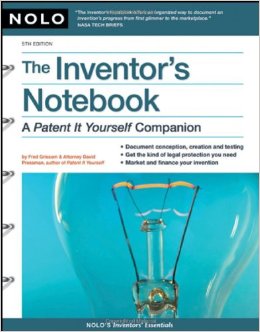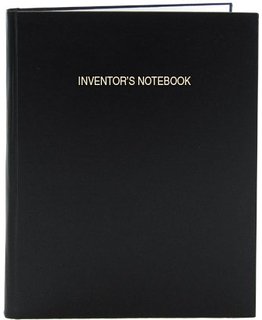
Top 10 Things to do Before Patenting your Invention
Our interviews with intellectual property and patent attorneys have yielded so much valuable information. If there’s one thing we’ve learned, it’s that independent entrepreneurs, inventors, and product developers can waste valuable time and resources by filing for a patent too soon. On the other hand, if you take it step by step and do your research before patenting your product idea, you will save a lot of time and money. With this in mind, we’ve created a checklist of the Top 10 Things to Do Before Patenting Your Product Innovation.
Remember, we are not attorneys and can’t give legal advice—it is up to you to do your research and make decisions for your business—but we do know manufacturing and have worked with many aspiring inventors over the years. So here are our top tips to get the wheels turning.
1. Work in an inventor’s notebook.
As of March 2013, the U.S. is a “first-to-file” country, which means that the rights to an invention are not given to the first to invent it but to the first to file a patent for that invention. That doesn’t mean that keeping an inventor’s journal or notebook isn’t necessary. It is! That record may help you show how and when certain aspects of your invention were devised, designed, and tested. An inventor’s notebook is also great for documenting and measuring progress as we test and refine our designs.
Don’t use just any old blank book. The preferred format is a bound journal with unlined, numbered pages. Here are some great examples of inexpensive inventor’s journals that you can purchase:
2) Do market research.
Patents are very time consuming and expensive to file and get approved. Take the time to do your own research to see if your idea is even worth it. Here are a few simple questions you can answer by visiting your local retail stores and doing some searches online. The devil’s in the details.
- Will your product sell?
- To whom?
- Where? Online? At trade shows? At ballgames/events? At brick-and-mortar stores? What kind of stores? Which stores?
- How will it be sold? Will you have special packaging requirements? Is it a seasonal product?
- At what price? Establishing a price point for your product is critical. Look at similar products on the market and determine how yours should be priced in comparison. This will come in handy as you research the cost of manufacturing your product. If you can expect low profit margins, patenting your idea may not be worth the cost.
- Who is your competition?
- Why is your product idea different?
Read our blog posts about market and product validation:
3) Determine whether your concept has crossed the idea/invention barrier.
Remember, you cannot patent an idea. The key is to take that idea, test it, refine it, redesign it. Each step will bring you closer to a tangible invention that is patentable.
4) Acquire and use a non-disclosure agreement.
NDAs are contracts, and they can be used to defend against infringement in ways that a patent cannot. Even if you have a patent or a patent pending, ask for a signed NDA before discussing your invention with anyone. Yes, sometimes certain clauses in an NDA can be negotiated, but it isn’t worth doing business with anyone who won’t stand behind their word and sign a non-disclosure agreement. You can download a free NDA template here: https://www.aireplastics.com/nda-templates/
Learn more about the benefits of NDAs here: https://www.aireplastics.com/nda/
5) Join an inventors group in your area.
Joining an inventors group will give you access to people just like you. You’ll meet beginners, others with a little experience, and even old pros, but all of them will be happy to share their experiences and offer the emotional and intellectual support you will need to get your product to market. Members will also know designers, suppliers, and manufacturers with honest records.
6) Make a simple prototype or mockup of your product idea.
Making a “works-like” or “looks-like” prototype will help you explain clearly how your invention works and how it solves problems for potential customers. You will also need it when presenting to possible licensees or investors.
I don’t recommend spending thousands of dollars on these first prototypes. You are not necessarily at the point in the project where you will need an exact finished model of your idea.
You can find more detailed information on creating your first prototype here: https://www.aireplastics.com/first-prototype.
7) Learn about the processes your product will need in order to be manufactured.
Visit maker spaces in your area. Talk to people in this industry. Learn about the costs of manufacturing your product. Often, this just requires a phone call or e-mail. Remember that manufacturers and designers are people like you. They are busy and have a limited amount of time, so be brief and to the point about your idea and the information you need. Usually, they will be happy to explain their processes.
I recommend researching the process you are inquiring about before making your first phone call. Getting even a rough idea of what is going on will help you ask the right questions and get the most out of every interaction. Remember that
business is about more than just hiring and paying for goods and services, it’s also about forming relationships with people you can understand and trust.
8) Make sketches and 3D models of your idea.
Having visual references of your inventions will help you tweak and make adjustments to it. They are also inexpensive ways to present your ideas without having to make a perfect prototype. You can find more on this subject in our article “How to Take Your Concept Sketches to 3D Models (No Sweat)”: https://www.aireplastics.com/concept-sketches-3d-models-no-sweat/
9) Get design for manufacturing/design for assembly (DFM/DFA).
If you’ve done your market research, understand the processes and costs necessary to produce your invention, and have a basic design for how it will work, you now need to have an expert design it specifically for the process in which it will be manufactured. This does require an investment if the product idea is complicated, but it’s a necessary step: You need to know exactly how your product will be made before you attempt to patent it.
There have been instances in which inventors couldn’t patent their specific invention because of prior art, but they were able to patent the manufacturing process to make the invention and therefore license the process to manufacturers. Again, devil…details…you get the picture.
Remember to include a clause in your agreement with the designer/engineer that states that any work done on your project is not a collaboration, but rather that you are hiring them to create and that the final designs and intellectual property created belong to you.
10) If necessary, file a provisional patent application (PPA).
You can file a provisional patent for between $65 and $130. You don’t need to have all of the specifics in order to file and you can use the “Patent Pending” label on your product for 12 months, after which you will need to file for an actual patent or let the idea go. This will give you some time to work on your project and show manufacturers, investors, and others that you understand the process and are serious about protecting your intellectual property. You will find a lot of information online about provisional patent applications. One of our recent interviewees, Gene Quinn, is an excellent resource. Check out these articles by him:
Here are my closing suggestions: Take control of your project. Learn everything you need to about bringing it to market. Do your own preliminary patent research before paying for professional research. Ask questions—there are no dumb questions. No one is going to bring this baby to life for you. If you want to be an independent inventor, entrepreneur, and product developer, you have to take action. The best part of all of this is that You Can Do It!
Jason Post
Director of Sales and Marketing
Writer, cartoonist, animation director and student of manufacturing.



